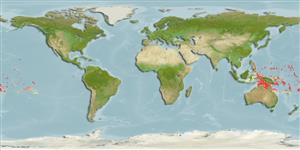>
Gobiiformes (Gobies) >
Microdesmidae (Wormfishes) > Ptereleotrinae
Etymology: Nemateleotris: Name from the combination of the Greek 'nemat' meaning thread, and the eleotrid genus Eleotris.; helfrichi: Named for Dr. Philip Helfrich, Associate Director of the Hawaii Institute of Marine Biology of the University of Hawaii and Director of the Enewetak Marine Biological Laboratory..
More on authors: Randall & Allen.
Environment: milieu / climate zone / depth range / distribution range
Ecologia
marino associati a barriera corallina; distribuzione batimetrica 0 - 90 m (Ref. 33482), usually 40 - ? m (Ref. 9710). Tropical; 16°N - 28°S
Southeastern Pacific: Fr. Polynesia.
Size / Peso / Age
Maturity: Lm ? range ? - ? cm
Max length : 6.0 cm TL maschio/sesso non determinato; (Ref. 9710)
Spine dorsali (totale): 7; Raggi dorsali molli (totale): 29-30; Spine anali 1; Raggi anali molli: 25 - 27. This species is distinguished by the following characters: D VI, I,30 (I,29-30); A I,26 (I,25-27); pectoral-fin rays 20 (20-21); pelvic-fin rays I,5; segmented caudal-fin rays 17; upper procurrent caudal-fin rays 9 (9-14); lower procurrent caudal-fin rays 12 (11-12); total caudal-fin rays 37-43; gill rakers 6 (5-7) + 17 (17-18) = 23 (22-24). Colouration: elevated part of first dorsal fin blue on anterior edge; median fins are pale yellowish green, caudal fin no markings, outermost edge of second dorsal and anal fin tipped with a yellow or orange spot, one in each interradial membrane space, the spots sometimes coalescing; when alive the body is lavender to lilac; pelvic fins black-tipped; dorsal edge of iris with a black mark at 1 o’clock position, sometimes continuing until interorbital space as a short streak; maxilla black (when alive and preserved); snout bright pink in life (Ref. 128599).
Occurs in relatively deep water. Found over small patches of sand, rubble, or hard open bottoms of steep seaward reefs. Rarely found in less than 40 m and frequently occurs in pairs. Monogamous (Ref. 52884). Feeds on zooplanktons (Ref. 89972). Minimum depth reported taken from Ref. 128797.
Life cycle and mating behavior
Maturità | Riproduzione | Deposizione | Uova | Fecundity | Larve
Monogamous mating is observed as both obligate and social (Ref. 52884).
Tea, Y.-K. and H.K. Larson, 2023. Synopsis of the ptereleotrine goby genus Nemateleotris, with description of a new species from the western and central Pacific Ocean (Teleostei: Gobiidae). Raffles Bulletin of Zoology 71:248-266. (Ref. 128599)
IUCN Red List Status (Ref. 130435)
Threat to humans
Harmless
Human uses
Acquario: Commerciale
Informazioni ulteriori
BibliografiaAcquacolturaProfilo di acquacolturaVarietàGeneticaElectrophoresesEreditarietàMalattieElaborazioneNutrientsMass conversion
Strumenti
Special reports
Download XML
Fonti Internet
Estimates based on models
Preferred temperature (Ref.
123201): 25.7 - 29, mean 27.8 °C (based on 13 cells).
Phylogenetic diversity index (Ref.
82804): PD
50 = 0.5625 [Uniqueness, from 0.5 = low to 2.0 = high].
Bayesian length-weight: a=0.00389 (0.00180 - 0.00842), b=3.12 (2.94 - 3.30), in cm total length, based on all LWR estimates for this body shape (Ref.
93245).
Trophic level (Ref.
69278): 3.4 ±0.45 se; based on food items.
Fishing Vulnerability (Ref.
59153): Low vulnerability (10 of 100).
